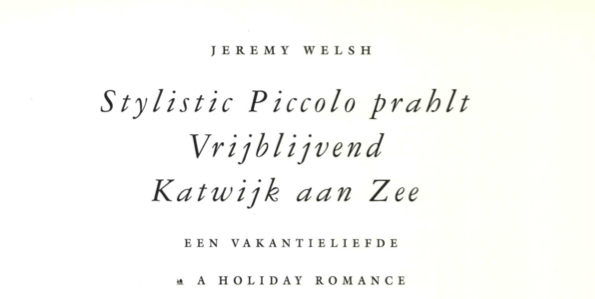Throughout the eighties, St James & Wilson have been creating cultural hybrids that attempt the problematic synthesis of Art and Popular Culture. Not that this fusion is in itself problematic, as much Eighties culture amply demonstrates, but die particular forms of Popular Culture chosen by the pair are uniformly sneered upon by the educated middle classes and the style conscious, streetwise pioneers of die Art/Pop frontier. Ballroom dancing, popular romantic fiction, the iconography of the English seaside guest house and the downbeat ‘common sense’ philosophy of their West Midlands working class background combine in works that also tackle social issues within a framework that owes much to the visual qualities and formal structures of the comic strip.
Through a creditable single-mindedness they have pursued their vision which has had its moments of fashionability amid longer periods of disfavour.
The experiment has not always worked. In particular, their contribution to the 1987 Euro TV omnibus Timccode was an unresolved attempt to transfer their sensibilities from a nominally Video Art context to a Television framework, and the problems they had in negotiating this path showed up all too clearly in the work. Hotel the Concept, the Exhibition, the Event, and to some extent the Video, represents the most ambitious and complete realisation to date of their ongoing project.
Mirrorhall Trappings
Arriving at the AIR Gallery for the opening of Hotel, we were greeted by uniformed and very courteous ushers who invited us to enter the lobby. People were milling about in a large lounge whose walls were decorated with large drawings of/by the artists in idealised settings, adopting the roles of romantic Hero and Heroine. In a small Television Room adjacent, Hotel the Video is playing to an appreciative audience.
More of this later. Downstairs, the usually cold and inhospitable basement has been transformed into a glitzy Piano Bar, in which avant garde musician John Tilbury will perform an avant gardist version of Piano Bar music. The Ballroom upstairs opens its doors and we pass through it, admiring its mirrorball trappings, to inspect the Shower with Hitchcock scenario video installed, the Lift with video screen motion simulation and finally the Bedroom, a cramped and claustrophobic closet of a room, perfeedy reminiscent of bad rooms in cheap hotels, in which a tv plays endless repeats of soap operas.
Throughout the month in which Hotel occupied the AIR Gallery, St James and Wilson kept up a constant attack upon our cultural preconceptions, staging events in which real ballroom dancers performed tangos and cha cha chas in a ballroom that is/was a gallery. We could choose to interpret these events as art performances, but the Hoteliers insist that the ballroom dancers are just being themselves, making their own art that does not need to be legitimized by forcing it into our definitions. However, we know that Marty and Anne themselves are accomplished ballroom dancers and that furthermore they have often used the Tango or the Foxtrot as an integral element of their own performances. Everything about the position they adopt is a refusal of rigid categories or purist conceptions of art.
What we did on our Holidays Narrative
Hotel the Video adopts similar strategies, refusing a rigid definition either stylistically or structurally. It is essentially a series of short vignettes, each of which is named after a room or a part of the hotel (The Lobby, The Dining Room, The Bathroom, etc.) that functions as a kind of What we did on our holidays narrative while exploring a variety of stereotypes and idealised notions of what The Hotel and The Holiday represent. The 20 minute tape was perfectly at home in Hotel the Installation, screened in a small intimate space that perfectly contextualised it. I can imagine that it will work equally well when screened on television, and it is an ideal video tape for domestic distribution, relying upon a construction of intimacy between the performers and the viewer. Consequently, when it received an official ‘premier’ (montits after the initial installation) in the Tate Gallery’s Clore Auditorium, all of the contextualising aspects that make it work were absent and the piece became oddly empty and awkward. As large screen projection, for perfectly logical reasons, takes over from monitor presentation as the preferred method of screening video, a frequently recurring problem emerges. Works that are specifically and self evidently made for television screens usually do not function effectively as cinema, and to present them as such is to undermine the intentions and the strategies of the artists.
The worst recent example of this was the Tate’s screening of Jan Dibbet’s TV as a Fireplace on a projection screen, and worse still, that the five separate tapes were run back to back creating a twenty' five minute, unwatchable ‘film’ of a fire.
After its run at AIR, the hotel moved on to the Towner Museum and Art Gallery in Eastbourne, on the south coast. Although I did not see the show at its second location, I can imagine the effect: a delicious confusion of terms whereby the original inspiration for the piece. The Grand Hotel Eastbourne, would be accessible to viewers of the installation, who could then cross reference the two. And the aesthetics that are parodied/appropriated/ interpreted in the installation would have a stronger resonance for the inhabitants of a town in which these aesthetics represent the dominant visual language. It would have been interesting if the art/life gap could have been further eroded by taking in guests, so that the tourist with an appetite for something slightly different could have spent his holiday in an art gallery posing as a hotel: - or should that be the other way around?
